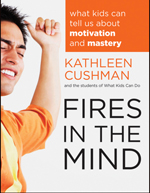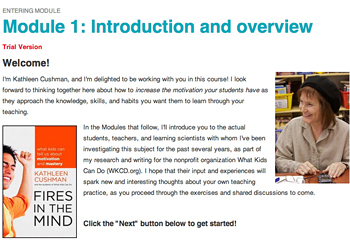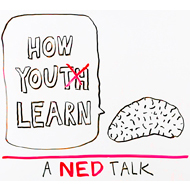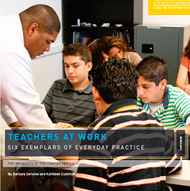

How Youth Learn: A Portfolio to Inform and Inspire Educators, Students, Parents & More
| WKCD Resources | Multimedia | SHARE |
Ned's GR8 8: An Insider's Guide to the Teenage Brain If you're a teenage speaker brought in to address a crowd of teachers on the subject of how you and your peers learn best . . . what are you going to say? "I—have no clue," Ned Cephalus nervously demurs, his voice cracking with shyness as he disclaims his "exper-tosity" from behind the podium in this new whiteboard animation from WKCD. "I'm just a very average teenage brain." Yet in his funny and fast-paced 6-minute "NED talk," this hand-drawn adolescent brain--complete with backpack, zits, and a journal he keeps about school--knocks out eight powerful conditions of learning that can change everything for students from rural Texas to New York City (where the owner of Ned's voice goes to high school). For those wanting to use Ned's GR8 8 for professional development, we've created a version with pauses for questions and reflection using the software platform Zaption. Click on the thumbnail below for Zaption's free online "tour" of Ned's GR8 8.
|
|
THE MOTIVATION EQUATION:
Designing Lessons that Set Kids’ Minds on Fire Teachers kept asking for more after our highly praised book Fires in the Mind recruited adolescents to investigate “the paths to passionate pursuit of something worthwhile” (Howard Gardner). Now comes the follow-up: a lively and discerning multi-media e-book that uses the actual work of teachers, the feedback of students, and the commentary of learning scientists to describe how — and why — high motivation and academic mastery develop in the classroom. Guided by an “actual adolescent brain” named Ned Cephalus and his pithy “Gr8 8” checklist for how youth learn, readers listen in as six case studies of highly effective curriculum and instruction unfold in diverse middle- and high-school settings. Throughout the book, readers use the research-based “Motivation Equation” to analyze what draws students into a learning challenge, helps them persist through difficulties, and brings them to mastery. iBook INCLUDES: • Audio and video clips of students, teachers, and scientists • Pop-up summaries of key research • Live links to related information • Downloadable worksheets for diagnosis and planning • Chapter-end discussion prompts for teacher book study • A lesson-study collegial protocol focused on motivatio |
To read in any browser, go to nextgenpress.creatavist.com Read it on the iPad and iPhone! Download our free Next Generation Press app here |
Online Lesson Study to Build Student Motivation Educators inspired to boost student motivation after reading WKCD’s recent book Fires in the Mind now have new support in making that happen. In a self-paced, online “Learning Path on Building Student Motivation,” author Kathleen Cushman presents six in-depth mixed-media case studies of highly motivating classroom practice—complete with commentary from learning scientists as well as from the teachers and students involved. That material forms the core of a collaborative social-learning experience that takes only six to eight hours of “anytime, anywhere” study. Small cohorts of participants hear from Cushman, analyze curriculum and instruction through the lens of the “Motivation Equation,” and come to new insights in a discussion forum. Participants keep a portfolio that aligns their work with the Danielson Teacher Effectiveness Rubric. COURSE OBJECTIVES • Understand the factors that are crucial to motivation • Develop skills for improving student expectations of success • Identify and apply the “building blocks of motivation and mastery” to the teaching and learning environment • Share classroom approaches to maintaining and increasing student motivation. |
|
Advice for Parents: How to Help Your Child Succeed in School — and Life For years WKCD has thought hard about how to better help parents help their kids succeed. We wanted to address character strengths kids develop through practice along with prescriptions about homework. We developed a 22-page handbook for parents that covers seven social and emotional strengths, along with two interactive multi-media presentations. We also have Spanish versions of the multi-media and workshop handouts, produced in part by first-generation Spanish-speaking students at Brown University. For copies, please contact info@whatkidscando.org |
The "Fires" Series WKCD first created Fires in the Bathroom (2003) as a guide in which urban youth explain themselves to new teachers who come from very differentbackgrounds than their students. But the book immediately struck a deep chord with veteran teachers as well — and adolescents from suburban and rural settings said they felt just the same way about their lives in school. Changing the national conversation about student engagement, this book’s compelling voices have made Fires in the Bathroom “a major contribution” (Teachers College Record) and a classic text in teacher education. Early adolescents had their turn to speak out in Fires in the Middle School Bathroom, which followed in 2008. Their words give teachers a poignantpicture of the unsteady ground that “tweens” negotiate as they leave childhood behind for more complicated territory ahead. Their social worlds, their personal preoccupations, and their ever-shifting energies inevitably arrive in the classroom with them, challenging their attention to the tasks of school. This book attunes teachers to the rewards of listening closely and using what we hear, as middle schoolers reveal the secrets of their developmental journey. Youth talk about their motivation to learn throughout the Fires series, and in Fires in the Mind (2010), WKCD asked high school students to investigate that more deeply. As they described the areas where they were already “getting really good” in school and out, these youth found that their experiences closely aligned with the scientific research on the development of expertise. This book raises important questions about how classroom learning can spark the same degree of engagement and effective practice that students speak of when describing their out-of-school activities. |
  |
Small Publications “First Ask, Then Listen: How to Get Your Students to Help You Teach Them Better” (PDF) This short manual describes the process and questions behind WKCD’s best-selling book Fires in the Bathroom. It offers prompts and exercises for teachers wanting to start a dialogue with their own students. The Practice Project (PDF) A five-day curriculum for secondary teachers or advisors in which students investigate the essential question: “What does it take to get really good at something?” SAT BRONX: DO You Know What Bronx Kids Know? (PDF) by students from Bronx Leadership Academy 2, BLA2 teachers Shannon O’Grady and Kristin Ferrales, and Kathleen Cushman (May 2008) What do inner-city teenagers know that the rest of us may not? What can they do that others might find daunting? What can we all learn, from thinking through the issues that confront urban youth? SAT Bronx aims to find out, by framing the words and experiences of fourteen Bronx high school students in the form of standardized test passages. To answer its multiple-choice questions one must analyze complex matters of culture, language, behavior, even governmental policy. |
Blogs We're Following |
|





